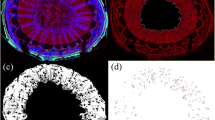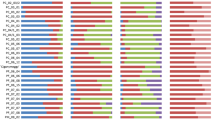Abstract
An anatomical study of roots and stems of five self-rooted cherry rootstocks with different growth control potentials was performed to compare their structure and xylem anatomy. The aim was to correlate anatomical parameters with rootstock dwarfing potential and theoretical hydraulic conductance (k h), and to evaluate the potential application of anatomical characteristics in the preselection process for prediction of ultimate tree vigor. One of the mechanisms of water transport efficiency reduction in dwarfing rootstock stems is from the rootstock xylem anatomy. Anatomical parameters of ‘Gisela 5’ and ‘Mazzard’ were typical for dwarfing and vigorous rootstocks, respectively, and were thus suggested as reference rootstocks. Significantly greater vessel diameter and frequency were found in invigorating and dwarfing rootstocks, respectively. Higher k h was obtained in roots, compared to stems, due to significantly larger vascular elements. Dwarfing rootstocks had lower k h due to small vessel lumens and percentage and, to a lesser extent, because of low wood/cortex ratios or percentage of wood. A higher percentage of wood or xylem in cherry roots and stems was not always positively correlated with their conductivity and vigor. Thus, these parameters cannot be reliably used in prediction of the ultimate vigor, although this method was previously suggested for some other fruit tree species. The most reliable anatomical parameters for that purpose proved to be vessel frequency, vessel lumen area, and percentage of vessels on wood cross section. These characteristics could thus be an effective way to estimate dwarfing capacity and could be applied in rootstock selection and breeding programs.







Similar content being viewed by others
References
Atkinson CJ, Else MA, Taylor, Dover CJ (2003) Root and stem hydraulic conductivity as determinants of growth potential in grafted trees of apple (Malus pumila Mill.). J Exp Bot 54(385):1221–1229
Basile B, Marsal J, DeJong TM (2003) Daily shoot extension growth of peach trees growing on rootstocks that reduce scion growth is related to daily dynamics of stem water potential. Tree Physiol 23:695–704
Beakbane AB, Thompson EC (1947) Anatomical studies of stems and roots of hardy fruit trees. IV. The root structure of some new clonal apple rootstocks budded with Cox’s Orange Pippin. J Pom Hort Sci 23(3, 4):206–211
Blažkova J (2004) Resistance to abiotic and biotic stressors in sweet cherry rootstocks and cultivars from the Czech Republic. J Fruit Ornam Plant Res 12:303–310
Castro-Diez P, Puyravaud JP, Cornelissen JHC, Villar-Salvador P (1998) Stem anatomy and relative growth rate in seedlings of a wide range of woody plant species and types. Oecologia 116:57–66
Dickison WC (2000) Integrative plant anatomy. Academic Press, San Diego, pp 280–281
Esau K (1977) Anatomy of Seed Plants, 2nd edn. Willey, New York, pp 128–135
Ewers FW (1985) Xylem structure and water conduction in conifer trees, dicot trees and lianas. IAWA Bull N. S 6(4):309–317
Fassio C, Heath R, Arpaia ML, Castro M (2009) Sap flow in “Hass” avocado trees on two clonal rootstocks in relation to xylem anatomy. Sci Hortic (Amsterdam) 120:8–13
Goncalves B, Correia CM, Silva AP, Bacelar EA, Santos A, Ferreira H, Moutinho-Pereira JM (2007) Variation in xylem structure and function in roots and stems of scion-rootstock combinations of sweet cherry tree (Prunus avium L.). Trees 21:121–130
Jones A, Reed R, Weyers J (2003) Practical skills in biology. Pearson Education Limited, London, p 525
Lang AG (2011) Producing first-class sweet sherries: Integrating new technologies, germplasm, and physiology into innovative orchard management strategies. In: Milatovic D (ed), Proceedings of the 3rd Conference on “Innovations in Fruit Growing,” Faculty of Agriculture, Belgrade, Serbia, pp 59–74
Long LE, Kaiser C (2010) Sweet cherry rootstocks for the Pacific Northwest. Pac Northwest Ext Publ PNW 619:1–8
McElrone AJ, Pockman WT, Martinez-Vilalta J, Jackson RB (2004) Variation in xylem structure and function in stems and roots of trees to 20 m depth. New Phytol 163:507–517
Meland M, Moe ME, Froynes O (2007) Differences in growth and development of functional xylem of grafted and budded sweet cherry trees. Acta Hortic 732:311–317
Miller SR, Nelson SH, Heeney HB (1961) Studies on apple rootstock selections relating respiration rates to an anatomical method of predicting dwarfness. Can J Plant Sci 41(2):221–226
Olmstead MA, Lang NS, Lang GA, Ewers FW, Owens SA (2004) Characterization of xylem vessels in sweet cherries (Prunus avium L.). Acta Hortic 636:129–135
Olmstead MA, Lang NS, Ewers FW, Owens SA (2006) Xylem vessel anatomy of sweet cherries grafted onto dwarfing and nondwarfing rootstocks. J Am Soc Hort Sci 131:577–585
Schweingruber FH (2007) Wood structure and environment. Springer-Verlag, Berlin, pp 10–256
Schweingruber FH, Börner A, Schulze ED (2008) Atlas of woody plant stems: evolution, structure and environmental modifications. Springer-Verlag, Berlin, p 99
Seleznyova AN, Tustin DS, Thorp TG (2008) Apple dwarfing rootstocks and interstocks affect the type of growth units produced during the annual growth cycle: precocious transition to flowering affects the composition and vigor of annual shoots. Ann Bot 101:679–687
Sellin A, Rohejärv A, Rahi M (2008) Distribution of vessel size, vessel density and xylem conducting efficiency within a crown of silver birch (Betula pendula). Trees 22:205–216
Tomaszewska Z, Nychnerewicz B (2006) The effect of rootstock on growth and fruitage of sweet cherry. Scientific Works of the Lithuanian Institute of Horticulture and Lithuanian University of Agriculture 25(3):224–229
Tombesi S, Johnson SR, Day KR, DeJong TM (2010a) Relationships between xylem vessel characteristics, calculated axial hydraulic conductance and size-controlling capacity of peach rootstocks. Ann Bot 105:327–331
Tombesi S, Johnson SR, Day KR, DeJong TM (2010b) Interactions between rootstock, inter-stem and scion xylem vessel characteristics of peach trees growing on rootstocks with contrasting size-controlling characteristics. AoB Plants 13:1–9
Trifilò P, Lo Gullo MA, Nardini A, Pernice F, Salleo S (2007) Rootstock effects on xylem conduit dimensions and vulnerability to cavitation of Olea europaea L. Trees 21:549–556
Tyree MT, Ewers FW (1991) The hydraulic architecture of trees and other woody plants. New Phytol 119:345–360
Végvári Gy, Hrotkó K, Magyar L, Hajagos A, Csigai K (2008) Histological investigation of cherry rootstocks. Acta Hortic 795:339–344
Vercambre G, Doussan C, Pages L, Habib R, Pierret A (2002) Influence of xylem development on axial hydraulic conductance within Prunus root systems. Trees 16:479–487
Zach A, Schuldt B, Brix S, Horna V, Culmsee H, Leuschner C (2010) Vessel diameter and xylem hydraulic conductivity increase with tree height in tropical rainforest trees in Sulawesi, Indonesia. Flora 205:506–512
Acknowledgments
This research was supported and funded by the Ministry of Education and Science, Republic of Serbia, as one of the research topics in the project “Selection of sweet and sour cherry dwarfing rootstocks and development of intensive cultivation technology based on sustainable agriculture principles,” evidence number TR 31038.
Author information
Authors and Affiliations
Corresponding author
Rights and permissions
About this article
Cite this article
Zorić, L., Ljubojević, M., Merkulov, L. et al. Anatomical Characteristics of Cherry Rootstocks as Possible Preselecting Tools for Prediction of Tree Vigor. J Plant Growth Regul 31, 320–331 (2012). https://doi.org/10.1007/s00344-011-9243-7
Received:
Accepted:
Published:
Issue Date:
DOI: https://doi.org/10.1007/s00344-011-9243-7




